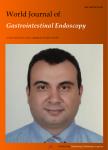Endoscopic papillectomy: The limits of the indication, technique and results
内镜papillectomy:适应症,技术和结果的限制作者机构:Division of Digestive and Endoscopic Surgery Department of Surgery and Anatomy Ribeirao Preto School of Medicine University of Sao Paulo Department of Surgery Hospital Federal dos Servidores do Estado Rua Sacadura Cabral Rio de Janeiro 20221-903 Brazil
出 版 物:《World Journal of Gastrointestinal Endoscopy》 (世界胃肠内镜杂志(英文版)(电子版))
年 卷 期:2015年第7卷第10期
页 面:987-994页
学科分类:10[医学]
主 题:Epidemiology Ampullary tumors Endo-scopic resection Endoscopic ultrasound Staging Endoscopic papillectomy Surgical ampullectomy
摘 要:In the majority of cases, duodenal papillary tumors are adenomas or adenocarcinomas, but the endoscopy biopsy shows low accuracy to make the correct differentiation. Endoscopic ultrasonography and endoscopic retrograde cholangiopancreatography are important tools for the diagnosis, staging and management of ampullary lesions. Although the endoscopic papillectomy(EP) represent higher risk endoscopic interventions, it has successfully replaced surgical treatment for benign or malignant papillary tumors. The authors review the epidemiology and discuss the current evidence for the use of endoscopic procedures for resection, the selection of the patient and the preventive maneuvers that can minimize the probability of persistent or recurrent lesions and to avoid complications after the procedure. The accurate staging of ampullary tumors is important for selecting patients to EP or surgical treatment. Compared to surgery, EP is associated with lower morbidity and mortality, and seems to be a preferable modality of treatment for small benign ampullary tumors with no intraductal extension. The EP procedure, when performed by an experienced endoscopist, leads to successful eradication in up to 85% of patients with ampullary adenomas. EP is a safe and effective therapy and should be established as the first-line therapy for ampullary adenomas.



